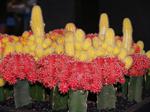How to Choose What Plants to Grow in a Nursery
 Perhaps the most important question for a nursery manager is: "What should I grow?"
Perhaps the most important question for a nursery manager is: "What should I grow?"
If you select the most appropriate varieties and grow the right quantities you will reduce wastage and maximise profits.
It is all very well to grow a plant because you like it, or because you think you can get the public excited about it,
but the backbone of the nursery industry has always been a range of very popular plants which, if grown well and sold in the right way at the right time, will always find a market.
Considerations for New Nurserymen
- You are limited by your skill, knowledge of the market, and money available to develop your operation. It is possible to start a profitable part time nursery in your home yard. This type of operation will provide a supplement to your normal income, and at the same time, allow you to learn from your experiences. A serious business venture is quite different though. You do not have time to learn by making mistakes!
- New nursery managers are better advised to avoid plants which are more difficult to propagate. These plants often require more time, more skill, and more sophisticated equipment. This means that they are more expensive to grow.
- Some plants require a greater length of time to bring to a saleable size.
- Most plants are normally sold at a standard size and packaged in a standard way. For example, shrubs are often sold in 200 250mm pots, deciduous trees are sold bare-rooted in winter, and vegetable seedlings are sold in plastic punnets. New nurserymen are advised to produce plants in the standard packaging. You know that the product will be saleable in this packaging!
- Low-growing shrubs and ground cover plants are generally in higher demand in urban areas compared to taller growing shrubs and trees. The highest demand for large shrubs and trees is with the rural community.
- A plant which has flowers on it is always more saleable.
- A plant without marks or damage on the leaves and stems is always more saleable.
Some plant varieties require more space than others. Sprawling climbers or ground cover plants can take up a lot of space whereas tall slender trees can take less space.
Slower growing plants do not have to be sold as soon as they are good enough for sale, but faster growing plants deteriorate more rapidly and so must be sold quickly unless you have the resources to continually keep potting them up into larger containers.
Some of the main choices are:
- Trees and shrubs: climbers, conifers, deciduous plants, ground covers, fruit trees and vines, native trees and shrubs, exotic trees and shrubs
- Bedding plants: annual seedlings
- Potted colour
- Indoor Plants
- Foliage plants: indoor foliage and flowering plants, hanging baskets, palms and ferns
- Edible Plants -Fruit, Vegetables, Herbs
- Perennials and cottage plants
- Bulbs and tubers
- Cacti and Succulents
- Water plants
- Bonsai
You may choose to have a general nursery, growing or selling a wide range of plant types.
Alternatively, you might prefer to choose a theme such as bonsai or cottage gardens or to concentrate on a specific type or variety of plant, such as carnations, fuchsias, roses or geraniums.
You may also be interested in....